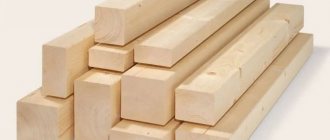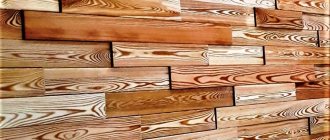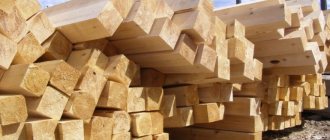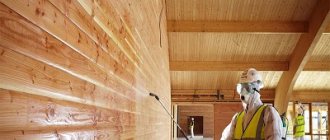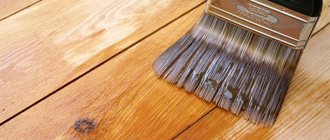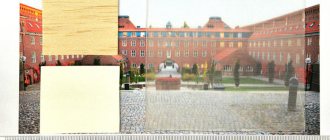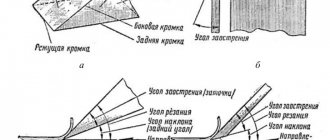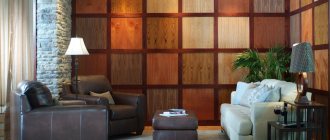Treatment of a wooden house after construction is an essential part of its operation. Without protection, the tree quickly darkens, deteriorates, rots, and insects appear inside. As a result, the appearance deteriorates and the service life is reduced. Proper treatment protects the walls from the sun, moisture and pests, and becomes an additional decoration of the cottage.
When processing a wooden house made of timber after construction, it is important to protect the surface, but preserve the natural properties of the materials. From the article you will learn when, how and with what to treat a wooden cottage so that it becomes beautiful, receives reliable protection and does not lose the pleasant aroma of a coniferous forest.
Tasks for painting walls from the inside:
- The coating protects the wall from dirt and abrasions. The sanded surface is easy to stain - the dirt eats into the wood, and sometimes you have to remove a layer of wood to remove it. It is much easier to wash off dirt from a painted wall.
- Paint is needed to protect against high humidity and direct ingress of water. If it is decided to leave exposed wood in the “wet zone,” then the walls are painted with a waterproof compound or covered with a moisture-resistant impregnation. This technology is used in bathrooms, swimming pools, and kitchen work areas.
- The right shade helps solve design problems. The color of the walls is chosen taking into account the purpose of the rooms: calm shades for bedrooms, neutral shades for common areas, bright shades for the kitchen and living room. It is important not to overdo it with saturation, otherwise the walls can visually reduce the volume of the room.
Bedroom in a house according to the SV-4 project
Methods for protecting wood from adverse factors
At the construction stage, constructive methods are used to protect timber from moisture, solar radiation, biological damage and fire. The measures consist of isolating wooden blanks from the ground, constructing well-ventilated canopies at a sufficient distance from flammable materials and open sources of fire. Installation work can last several months, so it is important to prevent deformation and premature destruction of the building material.
Along with constructive methods for wood processing, new generation antiseptics , which protect the material from moisture penetration and infection by fungal microorganisms for up to 8 months (for example, SENEZH EUROTRANS ).
If, after all, the logs are covered with dark spots of lesions, you can get rid of them using bleaching agents that contain chlorine or active oxygen.
Traditional chlorine-containing bleaches negatively affect wood, destroying its structure, so it is better to use advanced technologies that meet global environmental standards. The preparation "SENEZH NEO" based on active oxygen does not emit harmful substances and is suitable for treating wooden houses outside and inside.
Protective means for processing logs
Reliable and safe processing of a wooden house depends on what compounds it will be used with. On the modern market there are a large number of products from various manufacturers that promise one hundred percent protection against all kinds of impacts on wood. The most popular and proven include:
- “SENEZH” – tinting and preservative antiseptics based on water and acrylate, fire-bioprotective materials and bleaching agents. Russian production;
- “NEOMID” – antiseptics for interior and exterior work, repellents against insects and microorganisms, fire-retardant emulsions of efficiency groups 1 and 2, fire-retardant paint, wood-protective oil for baths and saunas. Manufacturer – Russia;
- “Belinka” – protective primer, colorless antiseptic, durable impregnation, water-based glaze for lightening, paint with an ultraviolet filter. Slovenia;
- “Tikkurila” – colorless oils and water-based antiseptics, glazing materials, pigment paints. Protection from moisture, mold, rot and solar radiation. Finland;
- "Rogneda" - safe fire and bioprotective compounds, bleaches and protective and decorative coatings. Active antiseptics destroy emerging lesions and provide protection from 15 to 50 years. Russia.
General recommendations for the use of antiseptics:
- the products are applied to the cleaned and degreased surface of the log;
- initially treat the affected areas;
- permissible temperature for organic compounds is above +50C;
- minimum temperature for using water-based products +100C;
- maximum air humidity – 80%;
- It is better to carry out external wall treatment in the shade of the house and move behind it while working;
- Fire-retardant impregnations and coatings are applied after treating the wall with an antiseptic.
External treatment of the house with protective compounds
Colorless water-soluble antiseptics are used as bioprotective primers of deep penetration. For exterior work, it is allowed to treat walls with organic-based compounds (for example, NEOMID 430 ECO or NEOMID 440 ECO ).
Impregnation penetration depth
The facade of the house is most susceptible to the influence of precipitation, so the logs are carefully coated with a protective compound, paying special attention to the end cuts. The lower part of the walls is impregnated with a special antiseptic against groundwater, seasonal flooding, microorganisms and rodents (for example, SENEZH ) .
Fire protection is then applied to the walls. For these purposes, there are fire-retardant coatings and impregnations. Protective paints, pastes, coatings hide the surface of the wood, so it is better to use an impregnating composition that is applied to the wall logs in several layers. For critical areas, use products of the 1st group of fire protection efficiency with control surface tinting (for example, NEOMID 020 ).
The final finishing is carried out with coating or glazing antiseptics, which emphasize the structure and color of the surface of the log. To hide a surface that has lost its original appearance, the facade can be painted with acrylate or oil paint. External coatings should be selected with ultraviolet protection (for example TIKKURILA WALTTI ).
Purposes of processing and painting walls outside:
- The coating prevents exposure to ultraviolet radiation. Direct sunlight discolors and dries out the outer part of the fibers, accelerating the destruction of wood. Unpainted areas quickly darken and become brittle.
- The paint coating film protects the walls from direct moisture. The paint does not absorb water - drops flow down the surface, the wood retains normal humidity. Without coating, the fibers swell, lose their shape, and cracks appear on the timber.
- The antiseptic protects the tree from insect pests, fungus, and mold. The wall is impregnated with an antiseptic before painting or multifunctional paints and varnishes are used.
- Paint affects the appearance of a building. When painting a wooden house, natural wood shades are often preserved, but there are houses made of timber in white, pink, blue and even black.
House according to project SP-4
Indoor treatment products
How to cover imitation timber, logs, clapboard or any other lumber? There are several types of preparations designed to protect wood from various adverse factors. The products are transparent, not hiding the natural texture of wood, but, on the contrary, emphasizing its beauty. You can also impregnate wood with tinting compounds that give it a darker shade.
Wall treatment in a wooden house can be done using the following means:
- antiseptics;
- flame retardants;
- biopyrenes;
- primers;
- bleaching compounds.
Antiseptic drugs
This group of products is intended to protect a house made of timber or logs from fungus and mold, as well as combat existing lesions.
Antiseptics are available in two types:
- Impregnated compounds that are deeply absorbed into the wood, forming a barrier in it that prevents biological damage. These impregnations can be very toxic, so before purchasing a product, you need to study its composition.
- Coating preparations that create a film on the surface that protects the wood from water and dampness.
Antiseptics are produced on various bases, but only water-soluble and combined formulations are suitable for treating the internal surface.
Water-based impregnations are the most preferred option because they do not contain harmful components and are safe for humans. However, they have one significant drawback - their protective properties decrease after a relatively short period of time. It is advisable to use these products under water-soluble paints.
Combined preparations containing oils and high-carbon components are excellent for rooms with high humidity.
There is also a separate type of antiseptics - biomoisture protective, which protect wood not only from the appearance of mold and mildew, but also from the development of microorganisms and insects in its structure. This impregnation for a wooden house performs two functions at once: it protects the wood and creates a beautiful decorative coating on the surface.
Fire retardants
As you know, wood is very flammable and can ignite even from one spark. To avoid this, wood is treated with fire retardants. Wood impregnated with a fire retardant is highly resistant to fire and can not ignite for a long time even in the presence of an open flame.
There are two types of fire retardants:
- Saline. Preparations containing salts, when wood is heated strongly, release gases that prevent rapid ignition.
- Non-salt solutions block fire using foam, which forms on the surface under the influence of fire.
Biopyrenes
Biopyrenes are products that combine an antiseptic and a fire retardant. They provide protection from both biological factors and fire. These preparations can be used to cover the walls and floors of the house, and they can also be used for external treatment.
Biopyrenes are the best overall protection because they save not only money, but also processing time.
Primers
Before painting, applying a primer is mandatory. The primer is a good protection for wood from various destructive processes, and it also ensures optimal adhesion of paint to wood. For timber inside the house, it is recommended to use aqueous primers, which are transparent, translucent and opaque.
Whitening products
If, during the shrinkage process, blue and dark spots appear on the interior walls of a wooden house, this indicates that a fungus has appeared in the wood structure, causing such manifestations. You can get rid of blue discoloration and fungal spores using special bleaching compounds.
In this case, many resort to folk remedies, such as bleach, hydrogen peroxide, and oxalic acid. These are simple and affordable drugs, but when used, there is a risk of misuse.
Today, modern industry produces the latest and very effective bleaches that provide a high degree of lightening and protection of wood. The products are produced in one- or two-component versions.
Why are the ends sealed?
A special sealant is applied to the ends of the beam, which completely blocks the ingress of water through the end cut, without interfering with natural moisture and air exchange. Without sealant, moisture quickly absorbs and evaporates through the cross section, the wood swells, cracks, and collapses. It is easier for pests to penetrate the tree through the end. The most correct option is to tightly seal the ends.
How to effectively protect a tree
How to treat the lining inside the house? This question is often asked by owners who have used wood in the interior decoration of their home.
Today, processing lining inside the house is not a problem. You just need to choose the right protective coating that will suit a particular room.
Some are more suitable for rooms with high humidity, others perfectly protect boards from ultraviolet rays, and some generally increase the strength of wood and prevent the risk of premature abrasion.
But also an important factor when processing is that the protection should look good on the boards . It should not distort the natural structure of the tree. On the contrary, its task is to emphasize the naturalness of the material used and blend harmoniously with the rest of the interior.
Most often, the following substances are used to protect wood:
Technologies for processing a wooden house made of timber after construction
Antiseptic . Necessary to prevent the formation of fungus, mold, and insect damage. For antiseptic use, special impregnations are used that penetrate the wood and destroy pests.
It is especially important to use an antiseptic if the construction is carried out from ordinary timber or logs - beetles and microorganisms often grow in heartwood. Logs are often completely immersed in antiseptic baths directly on the construction site and further treated after construction.
Glued laminated timber is not so susceptible to rotting - the manufacturing technology includes several mandatory stages of testing and chamber drying. Glued laminated timber is treated with an antiseptic on the outside - this is enough.
Painting . This is the final stage of processing a wooden wall - the composition with colorant is applied to the wood in 2-3 layers, creating protection from ultraviolet radiation and moisture. When painting, the wood texture is preserved (glaze coating) or completely hidden (covering).
The paint is applied in 2 or 3 layers with preliminary and intermediate sanding. Painting technology depends on the manufacturer's recommendations.
Complex processing .
To speed up and reduce the cost of processing, universal compositions are used: paint that contains an antiseptic. This approach speeds up construction and makes processing cheaper.
Protection of the log house with an antiseptic in two stages
Almost all purchased hand-cut log houses and log houses made from rounded logs are impregnated with antiseptics to the depth of the sapwood during their production.
Log houses are processed for the first time in the first warm season after construction. That is, if a log house is built in winter, processing is carried out in the spring. If a log house is built in the warm season, the log house is processed immediately after construction.
Important! Do not treat a wet log house with film-forming antiseptics. The antiseptic will seal the moisture inside the log and deep cracks will appear on the timber.
This does not mean that damp wood can be coated with impregnating antiseptics. The wood must be of normal (natural) humidity and coating the log beams with impregnating antiseptics is the first step in wood processing.
The second layer of treatment should be a film-forming glaze (transparent) layer of antiseptic. It will cover the wood with a film layer, which is already impregnated with an antiseptic inside.
Note! For log cabins that are already impregnated with antiseptics in production, they are coated only with a glazing antiseptic composition.
Basic stages of processing a wooden house after construction
- Checking humidity. For high-quality painting, the wall humidity should be within 12-15%.
- Primary grinding. Wood is sanded not only for leveling - mechanical processing opens the pores and ensures deep penetration of the antiseptic.
- Antiseptic. Pre-impregnation with an antiseptic is necessary when using regular wood paint. If the composition contains an antiseptic, the item is skipped.
- Padding. The primer penetrates the fibers and ensures a strong bond between the paint and varnish coating and the wall. When priming an external wall made of laminated veneer lumber, a thin layer of paint is usually used, which already contains an antiseptic.
- Intermediate sanding. Soft mechanical processing removes possible irregularities - when priming, the “pile” on the fibers rises.
- Application of intermediate and final coating. Three-layer painting creates the most saturated color and reliably protects the wood from precipitation, sun, and pests.
- End sealing. The sealant is applied according to the manufacturer's recommendations.
Types of antiseptics
Let’s not consider the miracle of “all in one” septic tanks, that is, antiseptics, in advertising, which they protect against all types of fungus and fire, inclusive. Let's follow the advice of experts and consider the step-by-step treatment of log wood with antiseptics and other protective compounds.
Antiseptics are divided according to composition:
- Opaque antiseptics;
- Transparent antiseptics. They are called glazes.
Based on their interaction with wood, all antiseptics are divided into:
Film-forming. After covering the wood, a protective film is formed on it. In addition to protecting wood, these antiseptics decorate wood. Film-forming antiseptics based on alkyd resins are not washed out by precipitation, but completely paint over the texture of the wood. Glazing film-forming antiseptics are washed out over time by precipitation and require constant renewal;
Impregnating. These antiseptics permeate the wood, deep inside. The most effective are non-washable formulations. They penetrate into the logs of the log house to the depth of the sapwood. They are odorless and allow the wood to breathe after impregnation. They are made on the basis of organic substances.
How to treat a wooden house after construction
To prevent protection from spoiling the feeling of a new wooden house, you need to choose a neutral composition of paints and varnishes. GOOD WOOD uses SEDIPAN products, a water-based acrylic paint. The coating applies smoothly, dries quickly, and leaves no odor.
For exterior painting, we use the WACT 640 line as a primer - the products contain a large amount of antiseptic and colorant, which additionally protects the wall from ultraviolet radiation. For interior decoration, it is enough to use WACT 650 - a paint with a lower antiseptic content. We seal the ends with a special compound WV 024, which completely blocks the sap-conducting channels, without disrupting the moisture and air exchange of the wood.
Sequence of protective wood treatment
Wood protection work includes:
- selection of a suitable antiseptic;
- surface preparation;
- treatment with an antiseptic composition;
- applying anti-foam;
- surface priming;
- finishing.
Surface preparation
The processing of a new wooden house or bathhouse is carried out after a series of preparatory measures.
In order for the antiseptic to be well absorbed and to fully demonstrate its protective properties, the wood must be dry and clean. The first stage of preparatory work is surface grinding. As a result of sanding, the top layer of wood is removed, bark residues are removed, dirt and bluish areas are removed. The sanded surface better absorbs the antiseptic, which penetrates deeply into the wood structure.
Sanding is no less important for an old wooden house. This operation allows you to level the surface and remove the previous paint coating. Before antisepticizing an old house, it is also necessary to putty the cracks and crevices, and then sand the surface again.
Next, the base is degreased using chemical means, for example, white spirit is well suited for this purpose.
Surface treatment with protective agents
First of all, external and then internal treatment of the timber with an antiseptic is performed.
First, damaged areas are treated (cuts, cuts, etc.), then impregnation is applied to hard-to-reach areas (ends and corners) and only after that the entire surface is treated. The ends need to be given special attention. These parts of the logs are more susceptible to rotting than other elements of the wooden structure, because... absorb moisture very quickly, so it is necessary to apply at least 4-5 layers of antiseptic to them. It is recommended to handle the ends exclusively with a brush, because no other method allows them to be processed with such care.
The rest of the surface is treated in two or three layers with a wide brush, roller or spray gun. First, apply one layer, and then, after waiting for it to dry, the treatment is repeated.
Using a brush or roller is quite difficult and takes a long time, but they can reach the most inaccessible areas. It is easy and quick to work with a spray gun, but there is a risk of missing some places where the spray gun cannot reach. It is best to use both methods: first apply impregnation to problem areas with a brush, and then spray the remaining surface.
After the antiseptic composition has dried, antiperen is applied to the logs - a product that will protect the log house from burning. The product penetrates deeply into the structure of the wood and allows the walls of the house to withstand open fire for several hours. Antiperen, as well as antiseptic, is applied in two layers.
Please note that most antiseptics contain compounds of copper, iron and chromium, which can cause inflammation and irritation of the skin. Therefore, it is imperative to use hand protection when processing.
Surface priming and finishing
After completing the protective surface treatment, all elements of the wooden structure must be primed. Priming is a mandatory step in preparing the surface for the subsequent application of the finishing coating. The primer removes small cracks, levels the base and ensures good adhesion of paints and varnishes to the wood.
The final stage is the application of a decorative coating, which improves the appearance of the house and protects the wood from solar radiation. The walls of a wooden house can be varnished, painted with covering paint, or impregnated with wax.
Processing results
- Long-lasting barrier against pests, insects, fungus. The sealant protects the end, the antiseptic impregnates the outer part, and the paint prevents the protection from being washed away.
- Ultraviolet light does not cause wood to darken. The house retains its “fresh” color. If the color is chosen correctly, then there is no resin release or burnout on the surface.
- Moisture protection. The film covers the entire wall, even after a serious rainfall the walls do not get wet.
- The house corresponds to the design project. The cottage is beautiful inside and out.
Rating of antiseptics
Belinka (Slovenia). Deep penetration antiseptic, provides effective protection against UV radiation, moisture and insects.
Senezh (Russia). The company produces more than twenty types of antiseptics, which are of high quality at an affordable price. If you are interested in how to get rid of mold on the walls of a wooden house, then the preservative antiseptic Senezh, which is effective even in the most severe cases of biological damage to wood, is perfect for these purposes.
Neomid (Russia). Affordable and high-quality universal products that are suitable for deep and decorative processing.
When to treat a wooden house
It is recommended not to delay with protective coatings and to paint the house in the first 3-6 months after construction. Before painting, be sure to check the humidity of the walls - manufacturers of paints and varnishes usually indicate 12-15% in the instructions.
Question to a specialist: - Is it possible to paint a house in winter? — Most paints and varnishes are applied at a temperature not lower than 15 °C. If you need to paint a house in winter, we build greenhouses and heat it with heat guns. If the technology is followed, the paint will not dry for long.
Processing sequence inside the house
Primary processing of lumber usually takes place at the production stage. If you purchased untreated logs, you need to process them yourself before building the house. For this purpose, special transport impregnations are used; usually their validity period does not exceed eight months. Thus, these means provide protection for logs only during the construction period.
After construction is completed, the effect of the antiseptic has already expired, and the house remains unprotected. This is a very difficult period for a wooden house; it will have to go through a long process of shrinkage, which lasts from six months to two years. How to protect a log house during this period? At this time, a second protective treatment of the log house inside the house must be carried out. For re-processing, products are used that provide complete protection from any natural factors, but at the same time do not interfere with the air exchange and shrinkage processes taking place in the wood.
After the structure has undergone shrinkage, the main finishing work is carried out, including complex internal treatment of the wooden house with protective impregnating compounds. Then the treated log house can be painted, varnished, and decorated with decorative materials.
Where to order treatment at home
It doesn’t matter who paints the cottage - a construction company or a third-party team. The main thing is that painters know how to work with wood. GOOD WOOD has its own painting department, where you can order professional finishing of a laminated timber home. All work is controlled by a technical supervision engineer.
Checking the thickness of the paint coating is an important point in the painting phase. Want to know more about painting? Call GOOD WOOD and schedule an appointment with a painting representative. If necessary, a specialist visits the site, assesses the condition of the walls, helps you choose the color and treatment option.
How to treat lining inside a house - a short guide
Both internal and external wall cladding with clapboard is an excellent solution for an owner who cares about the condition of his home. Interior decoration will create a cozy and healthy atmosphere in the room. The external one will protect the facade of the building from unnecessary damage.
In this article we will dwell in detail on why to treat the lining, what protective composition is best to do this, what is the technology for applying paints and varnishes, and also what amount should you expect when painting.
Tools for painting operations
We answered the question of how to treat the lining, but there was one more question: how to treat the lining inside the house?
Its importance lies in the fact that all compositions are different in consistency, so you should pay special attention to the selection of tools so that applying the protective layer is convenient and effective.
An approximate list of what is needed when applying paint and varnish mixtures:
- Napkins
- Construction tape
- Scotch Brite
- Sandpaper (#240)
- Tray for paint or varnish
- Roller
- Brushes
Whitening
This process is the first step when painting with any composition.
It involves cleaning the boards from any contaminants.
If there are difficulties with selecting bleach, then it is best to use a special stain.
After the bleaching process is completed and the lining becomes a clean canvas, you can proceed to the second stage - priming. The third stage is applying paint.
Tools needed for whitening:
- Roller
- Tassels
- Stain (bleach)
- Solvent
- Gloves
- Eye protection glasses
Video - glazing of wooden surfaces:
We paint according to the rules
If the wooden surface has already been painted several times, then before applying a fresh layer of varnish, it is necessary to evaluate the quality.
If it is still good, then you can wipe it with a 2% soda solution.
To prepare such a solution you need 10 liters of heated water and 300 grams of soda.
After treatment with soda solution, the working surface should be puttied and treated with drying oil. After this procedure, all wooden surfaces in the house will be significantly transformed.
If painting the lining inside the house is the first time, professionals advise adhering to a certain technology in this matter in order to avoid smudges and unevenness.
Related article: Wall cladding with PVC panels installation technology
Paintwork products should be applied using bristle tips. It is very important that it is thin. Otherwise, a large amount of paint may become unusable. To prevent the lint from leaving a mark on the walls and ceiling being treated, it is better to treat them with a soap solution before starting painting.
Video - how to properly treat the walls inside the house: Particular care should be taken when applying the final layer. To ensure an even coating, it is best to start applying the protective composition from the top. Hard-to-reach places, for example, frames, baseboards, and the space near radiators, are best painted with a brush that has a diameter of no more than 5 cm.
It is best to start painting the door from the paneled side.
A dry brush will help prevent paint smudges. Upward movements of the brush will remove unnecessary imperfections from the surface.
Video - painting the inside of the house:
Cost of work
The price of painting lining per square meter is approximately 280 rubles.
One square meter of the lining itself will cost the buyer approximately 320 rubles. But the cost of the boards is significantly influenced by the wood from which they are made and its grade.
Varnish for treating wood can be bought for approximately 260 rubles per liter.
We hope that this article will help every owner paint the lining with high quality, as well as choose the right materials. Good luck with your work.
